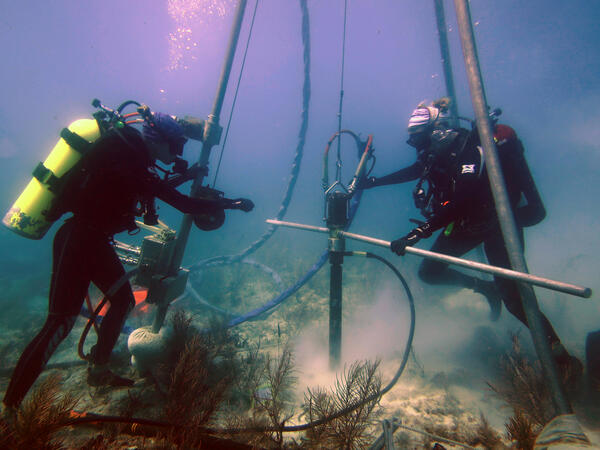Research Oceanographer Lauren Toth and student volunteer Liz Whitcher drill a coral-reef core from a reef off Key West, Florida, in the Florida Keys National Marine Sanctuary. Photo taken under research permit FKNMS-2015-058. Credit: Anastasios Stathakopoulos, USGS.
Anastasios Stathakopoulos
Anastasios Stathakopoulos is a Physical Scientist at the St. Petersburg Coastal and Marine Science Center in St. Petersburg, Florida.
Science and Products
Coral Reef Ecosystem Studies (CREST)
Measuring Coral Growth to Help Restore Reefs
Radiometric Ages and Descriptive Data for Late Holocene Acropora spp. Corals From Dry Tortugas National Park
U-series Ages and Elevation Data of Late Pleistocene Corals From the Florida Keys
Experimental Coral-Physiology Data for Acropora palmata in Florida, USA
Experimental Coral-Growth Data and Time-Series Imagery for Acropora palmata and Pseudodiploria strigosa in St. Croix, U.S. Virgin Islands
Experimental coral-growth and physiological data and time-series imagery for Porites astreoides in the Florida Keys, U.S.A.
Radiometric Ages and Descriptive Data for Holocene Corals From Southeast Florida
Experimental coral-growth data and time-series imagery for Acropora palmata in the Florida Keys, U.S.A.
South Florida Holocene Coral Sea-level Database
The Absolute and Relative Composition of Holocene Reef Cores From the Florida Keys Reef Tract
Experimental Data on Construction and Erosion of Orbicella Coral Reefs in the Florida Keys, U.S.A.
Descriptive Core Logs, Core Photographs, Radiocarbon Ages, and Accretion Data from Holocene Reef Cores Collected Throughout the Florida Keys Reef Tract
Experimental data comparing two coral grow-out methods in nursery-raised Acropora cervicornis

Research Oceanographer Lauren Toth and student volunteer Liz Whitcher drill a coral-reef core from a reef off Key West, Florida, in the Florida Keys National Marine Sanctuary. Photo taken under research permit FKNMS-2015-058. Credit: Anastasios Stathakopoulos, USGS.
Heterotrophy, microbiome, and location effects on restoration efficacy of the threatened coral Acropora palmata
The potential for coral reef restoration to mitigate coastal flooding as sea levels rise
Climate and the latitudinal limits of subtropical reef development
Physiological differences in bleaching response of the coral Porites astreoides along the Florida Keys reef tract during high-temperature stress
Reestablishing a stepping-stone population of the threatened elkhorn coral Acropora palmata to aid regional recovery
A revised Holocene coral sea-level database from the Florida reef tract, USA
The unprecedented loss of Florida's reef-building corals and the emergence of a novel coral-reef assemblage
Improving estimates of coral reef construction and erosion with in-situ measurements
A 3,000‐year lag between the geological and ecological shutdown of Florida's coral reefs
Plasticity in skeletal characteristics of nursery-raised staghorn coral, Acropora cervicornis
The structure and composition of Holocene coral reefs in the Middle Florida Keys
The relationship between the ratio of strontium to calcium and sea-surface temperature in a modern Porites astreoides coral: Implications for using P. astreoides as a paleoclimate archive
Science and Products
Coral Reef Ecosystem Studies (CREST)
Measuring Coral Growth to Help Restore Reefs
Radiometric Ages and Descriptive Data for Late Holocene Acropora spp. Corals From Dry Tortugas National Park
U-series Ages and Elevation Data of Late Pleistocene Corals From the Florida Keys
Experimental Coral-Physiology Data for Acropora palmata in Florida, USA
Experimental Coral-Growth Data and Time-Series Imagery for Acropora palmata and Pseudodiploria strigosa in St. Croix, U.S. Virgin Islands
Experimental coral-growth and physiological data and time-series imagery for Porites astreoides in the Florida Keys, U.S.A.
Radiometric Ages and Descriptive Data for Holocene Corals From Southeast Florida
Experimental coral-growth data and time-series imagery for Acropora palmata in the Florida Keys, U.S.A.
South Florida Holocene Coral Sea-level Database
The Absolute and Relative Composition of Holocene Reef Cores From the Florida Keys Reef Tract
Experimental Data on Construction and Erosion of Orbicella Coral Reefs in the Florida Keys, U.S.A.
Descriptive Core Logs, Core Photographs, Radiocarbon Ages, and Accretion Data from Holocene Reef Cores Collected Throughout the Florida Keys Reef Tract
Experimental data comparing two coral grow-out methods in nursery-raised Acropora cervicornis

Research Oceanographer Lauren Toth and student volunteer Liz Whitcher drill a coral-reef core from a reef off Key West, Florida, in the Florida Keys National Marine Sanctuary. Photo taken under research permit FKNMS-2015-058. Credit: Anastasios Stathakopoulos, USGS.
Research Oceanographer Lauren Toth and student volunteer Liz Whitcher drill a coral-reef core from a reef off Key West, Florida, in the Florida Keys National Marine Sanctuary. Photo taken under research permit FKNMS-2015-058. Credit: Anastasios Stathakopoulos, USGS.



